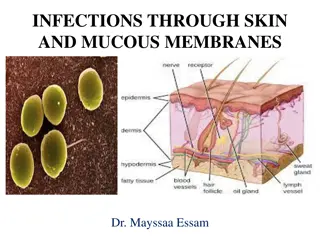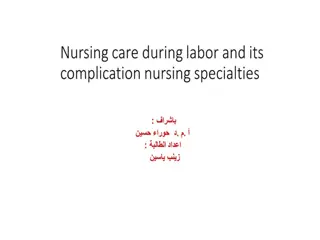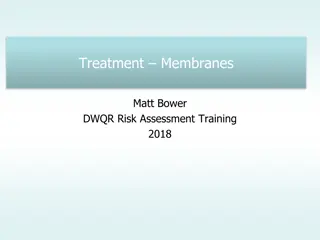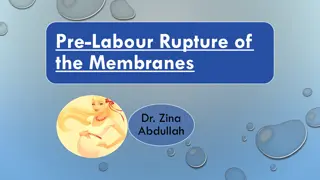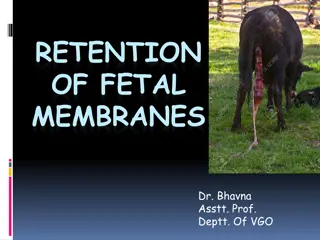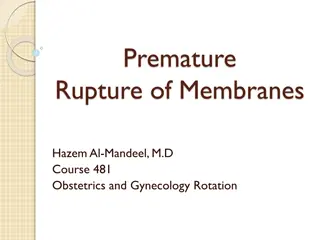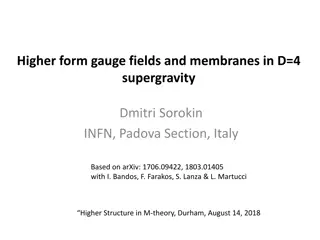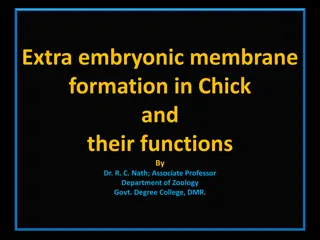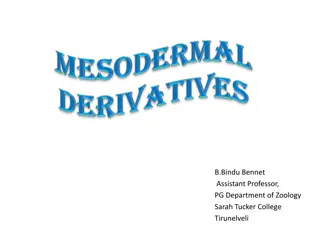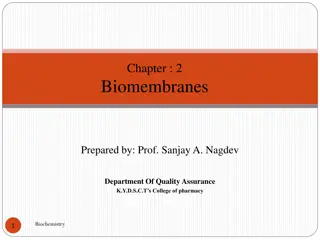Prelabor Rupture of Membranes and PROM
Rupture of membranes during pregnancy can occur before labor (prelabor) or preterm, leading to different risks for both mother and baby. Factors influencing preterm PROM, risks associated with term PROM, fetal risks following preterm PROM, and outcomes of periviable PROM are discussed. Maternal risks include infection, hemorrhage, and sepsis, emphasizing the importance of timely management and monitoring in such cases.
Download Presentation

Please find below an Image/Link to download the presentation.
The content on the website is provided AS IS for your information and personal use only. It may not be sold, licensed, or shared on other websites without obtaining consent from the author.If you encounter any issues during the download, it is possible that the publisher has removed the file from their server.
You are allowed to download the files provided on this website for personal or commercial use, subject to the condition that they are used lawfully. All files are the property of their respective owners.
The content on the website is provided AS IS for your information and personal use only. It may not be sold, licensed, or shared on other websites without obtaining consent from the author.
E N D
Presentation Transcript
Prelabor Rupture of Membranes Berry A. Campbell, MD
PROM Etiology Term: Normal physiology; infection Preterm: Infection; cervical insufficiency; SCH
Preterm PROM Risk Factors Hx PPROM, PTL Short cervix, cervix insufficiency 2ndor 3rdtrimester bleeding (previa, abruptio) SCH, smoker, drugs Low BMI, Low SE group
Term PROM 8% of pregnancies 50% ROM delivery by 33 hours 95% deliver within 94-107 hours with oxytocin, PG Most significant risk: infection - risk with latency
Preterm PROM 30% delivery within 1stweek Latency inversely correlated to GA at rupture 15-35% clinically evident chorio 15-25% develop pp infection 2-5% risk abruptio
Preterm PROM Fetal/NEO Risks RDS Sepsis IVH NEC Neuro developmental effects
Periviable PROM Approximately 1% of pregnancies or less Neo survival better if > 22 weeks (58 vs 14%)
Periviable PROM Maternal Risks IAI, endometritis Abruptio Retained placenta
Periviable PROM Maternal Risk Serious morbidity in 14% (Sepsis, hemorrhage, transfusion, ARI, infection, readmission) Life threatening infection (sepsis) in 1-5% of cases Kibel M, et al. Obstet Gynecol 2016;128:313-20 (Level II-2) Waters TP, et al. Am J Obstet Gynecol 2009; 201:230-40. (Level III) Dotters-Katz SK, et al. Obstet Gynecol 2017; 129:101-6. (Level 11-2)
Periviable PROM 40-50% deliver - 1stweek 70-80% deliver within 2-5 weeks Kibel M, et al. Obstet Gynecol 2016;128:313-20 (Level II-2) Waters TP, et al. Am J Obstet Gynecol 2009; 201:230-40. (Level III) Schucker JL, et al. Semin Perinatol 1996; 20:389-400. (Level III) Muris C, et al. Eur J Obstet Gynecol Reprod Biol 2007; 131:163-8. (Level III)
Periviable ROM & Pulm Hypoplasia Risk difficult to delineate (2-20%) Greatest risk if < 20 weeks RF: early, no AF Other neo risks: contractures
Management of Prelabor Rupture of Membranes by Gestational Age Term (37 0/7 weeks of gestation or more) GBS prophylaxis as indicated Treat intraamniotic infection if present Proceed toward delivery (induction or cesarean as appropriate/indicated) Abbreviation: GBS, group B streptococci. *Do not delay delivery for steroids; steroids should not be administered for an imminent cesarean birth. Magnesium sulfate for neuroprotection in accordance with one of the larger studies. z The combination of birth weight, gestational age, and sex provide the best estimate of chances of survival and should be considered in individual cases. Periviable birth. Obstetric Care Consensus No. 6. American College of Obstetricians and Gynecologists. 2017;130:187 99. May be considered for pregnant women as early as 23 0/7 weeks of gestation. ACOG Practice Bulletin 2020, Number 217
Management of Prelabor Rupture of Membranes by Gestational Age Late Preterm (34 0/7 36 6/7 weeks of gestation) Expectant management or proceed toward delivery (see text) (induction or cesarean as appropriate/indicated) Single-course of corticosteroids, if steroids not previously given, if proceeding with induction or delivery in no less than 24 hours and no more than 7 days, and no evidence of chorioamnionitis* GBS screening and prophylaxis as indicated Treat intraamniotic infection if present (and proceed toward delivery) Abbreviation: GBS, group B streptococci. *Do not delay delivery for steroids; steroids should not be administered for an imminent cesarean birth. Magnesium sulfate for neuroprotection in accordance with one of the larger studies. z The combination of birth weight, gestational age, and sex provide the best estimate of chances of survival and should be considered in individual cases. Periviable birth. Obstetric Care Consensus No. 6. American College of Obstetricians and Gynecologists. 2017;130:187 99. May be considered for pregnant women as early as 23 0/7 weeks of gestation. ACOG Practice Bulletin 2020, Number 217
Management of Prelabor Rupture of Membranes by Gestational Age Preterm (24 0/7 33 6/7 weeks of gestation) Expectant management Antibiotics recommended to prolong latency if there are no contraindications Single-course of corticosteroids; insufficient evidence for or against rescue course Treat intraamniotic infection if present (and proceed to delivery) A vaginal rectal swab for GBS culture should be obtained at the time of initial presentation and GBS prophylaxis administered as indicated. Magnesium sulfate for neuroprotection before anticipated delivery for pregnancies, 32 0/7 weeks of gestation, if there are no contraindications Abbreviation: GBS, group B streptococci. *Do not delay delivery for steroids; steroids should not be administered for an imminent cesarean birth. Magnesium sulfate for neuroprotection in accordance with one of the larger studies. z The combination of birth weight, gestational age, and sex provide the best estimate of chances of survival and should be considered in individual cases. Periviable birth. Obstetric Care Consensus No. 6. American College of Obstetricians and Gynecologists. 2017;130:187 99. May be considered for pregnant women as early as 23 0/7 weeks of gestation. ACOG Practice Bulletin 2020, Number 217
Management of Prelabor Rupture of Membranes by Gestational Age Periviable (Less than 23 24 weeks of gestation)z, Patient counseling; consider neonatology and maternal fetal medicine consultation Expectant management or induction of labor Antibiotics may be considered as early as 20 0/7 weeks of gestation GBS prophylaxis is not recommended before viability Corticosteroids are not recommended before viability Tocolysis is not recommended before viability Magnesium sulfate for neuroprotection is not recommended before viability , Abbreviation: GBS, group B streptococci. *Do not delay delivery for steroids; steroids should not be administered for an imminent cesarean birth. Magnesium sulfate for neuroprotection in accordance with one of the larger studies. z The combination of birth weight, gestational age, and sex provide the best estimate of chances of survival and should be considered in individual cases. Periviable birth. Obstetric Care Consensus No. 6. American College of Obstetricians and Gynecologists. 2017;130:187 99. May be considered for pregnant women as early as 23 0/7 weeks of gestation. ACOG Practice Bulletin 2020, Number 217
Preterm PROM Delivery Expectant to 34 weeks, then deliver Recent study: 1839 patients 34-36 6/7 no difference neonatal sepsis or composite neonatal morbidity Immediate delivery: Higher RDS and mech vent more ICU days; Higher CS risks Delayed delivery: Lower maternal risk Morris JM, et al. Lancet 2016; 387:444-52. (Level I) Quist-Nelson J, et al. Obstet Gynecol 2018; 131:269-79 (Meta-Analysis)
Periviable ROM Admit 23 obs No evidence labor, infection weekly visits Strict precautions
Periviable and Preterm PROM IAI signs/Sx may be subtle! Tocolytics individualize Steroids repeat course x1 Latency Abs yes on admission
Preterm PROM HSV HIV




